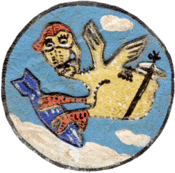356th Airlift Squadron
| 356th Airlift Squadron | |
|---|---|
|
356th Airlift Squadron Patch | |
| Active |
28 January 1942 – 10 April 1944 7 July 1944 – 15 April 1946 27 June 1949 – 28 January 1950 14 June 1952 – 30 June 2006 9 January 2007 – Present |
| Country | United States |
| Branch | United States Air Force |
| Type | Airlift |
| Part of |
Air Force Reserve Command 4th Air Force 433d Airlift Wing 433d Operations Group |
| Garrison/HQ | Kelly Field Annex |
| Decorations |
Distinguished Unit Citation Air Force Outstanding Unit Award Republic of Vietnam Gallantry Cross with Palm |
The 356th Airlift Squadron (356 AS) is a United States Air Force Reserve squadron, assigned to the 433d Operations Group, stationed at Kelly Field Annex, Joint Base San Antonio, Texas.
Overview
The squadron operates the Air Force Reserve's only Formal Training Unit providing initial and advanced C-5 flight qualification for Air Mobility Command, Air National Guard and Air Force Reserve Command aircrews.
History
Activated in early 1942 as a B-24 Liberator Operational Training Unit (OTU), later becoming a Replacement Training Unit (RTU) for deployed combat units, assigned to II Bomber Command. Inactivated in April 1944 when heavy bomber training ended.
Redgesignated as a B-29 Superfortress very heavy bombardment Squadron under Second Air Force on 1 April 1944 at Dalhart Army Airfield, Texas. Initially equipped with B-17 Flying Fortresses for training, due to shortage of B-29 Superfortresses. Moved to Harvard Army Airfield, Nebraska, in August 1944 and equipped with B-29B limited production aircraft.
After completion of training deployed to Central Pacific Area (CPA), assigned to XXI Bomber Command, Northwest Field (Guam) for operational missions. B-29Bs were standard production aircraft stripped of most defensive guns to increase speed and bomb load, The tail gun was aimed and fired automatically by the new AN/APG-15B radar fire control system that detected the approaching enemy plane and made all the necessary calculations.
Mission of the squadron was the strategic bombardment of the Japanese Home Islands. Dntered combat on 16 June 1945 with a bombing raid against an airfield on Moen. Flew first mission against the Japanese home islands on 26 June 1945 and afterwards operated principally against the enemy's petroleum industry. Flew primarily low-level, fast attacks at night using a mixture of high-explosive and incendary bombs to attack targets.
Flew last combat mission on 15 August 1945, later flew in "Show of Force" mission on 2 September 1945 over Tokyo Bay during formal Japanese Surrender. Inactivated on Guam 15 April 1946, personnel returned to the United States and aircraft sent to storage in Southwest United States.
It trained for C-54 airlift operations from 1949–1950 and for troop carrier missions from 1952–1967. The squadron airlifted troops and their equipment during the Cuban Missile Crisis, October–November 1962. From 1970–1971 the squadron trained for special operations.
Between 1971 and 2006 it trained for and flew airlift missions, participating in exercises, supporting unit deployments, taking part in special assignment airlift missions, and rotating periodically to Panama. The 356th supported liberation of Kuwait in 1991. It converted from tactical to strategic aircraft in 1992.
Since 2007 the 356th has conducted air crew training for the C-5 Galaxy.
Operations and Decorations
- Combat Operations: Combat in Western Pacific, 23 Jun-14 Aug 1945. Airlifted troops and their equipment during the Cuban missile crisis, Oct-Nov 1962. Vietnam War; Supported liberation of Kuwait in 1991.
- Campaigns: Air Offensive, Japan; Eastern Mandates; Western Pacific. Southwest Asia: Liberation and Defense of Kuwait; Operation Desert Shield
- Decorations: Distinguished Unit Citation, Japan 6-13 Jul 1945 Air Force Outstanding Unit Award: 1 Jan 1977-31 Dec 1978; 1 Oct 1999-30 Sep 2001. Republic of Vietnam Gallantry Cross with Palm, 14 Feb-11 Mar 1968.
Lineage

- Constituted 356 Bombardment Squadron (Heavy) on 28 Jan 1942
- Activated on 1 Jun 1942
- Inactivated on 10 Apr 1944
- Redesignated 356 Bombardment Squadron, Very Heavy on 27 Jun 1944
- Activated on 7 Jul 1944
- Inactivated on 15 Apr 1946
- Redesignated 356 Troop Carrier Squadron, Medium on 16 May 1949
- Activated in the Reserve on 27 Jun 1949
- Inactivated on 28 Jan 1950
- Activated in the Reserve on 14 Jun 1952
- Ordered to Active Service on 28 Oct 1962
- Relieved from Active Duty on 28 Nov 1962
- Redesignated: 356 Tactical Airlift Squadron on 1 Jul 1967
- Redesignated: 356 Special Operations Squadron on 25 Jun 1970
- Redesignated: 356 Tactical Airlift Squadron on 26 Jul 1971
- Redesignated: 356 Airlift Squadron on 1 Feb 1992
- Inactivated on 30 Jun 2006
- Activated in the Reserve on 9 Jan 2007.
Assignments
- 302d Bombardment Group, 1 Jun 1942 – 10 Apr 1944
- 331st Bombardment Group, 7 Jul 1944 – 15 Apr 1946
- 302d Troop Carrier Group, 27 Jun 1949 – 28 Jan 1950; 14 Jun 1952
- 302d Troop Carrier Wing, 14 Apr 1959
- 907th Troop Carrier (later, 907 Tactical Airlift; 907 Special Operations; 907 Tactical Airlift) Group, 11 Feb 1963
- 302d Tactical Airlift Wing, 1 Sep 1975
- 907th Tactical Airlift (later, 907 Airlift) Group, 1 Apr 1981
- 907th Operations Group, 1 Aug 1992
- 445th Operations Group, 1 Oct 1994 – 30 Jun 2006
- 433d Operations Group, 9 Jan 2007–Present
Bases stationed
|
|
Aircraft operated
|
|
References
![]() This article incorporates public domain material from websites or documents of the Air Force Historical Research Agency.
This article incorporates public domain material from websites or documents of the Air Force Historical Research Agency.
- Maurer, Maurer, ed. (1982) [1969]. Combat Squadrons of the Air Force, World War II (PDF) (reprint ed.). Washington, DC: Office of Air Force History. ISBN 0-405-12194-6. LCCN 70605402. OCLC 72556.
- USAF 356th Airlift Squadron History
- 356th Airlift Squadron Fact Page
External links
| |||||||||||||||||||||||||||||||||||||||||||||||
| ||||||||||||||||||||||||||||||||||


